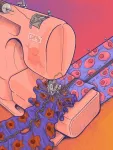(Press-News.org) Magic tricks make the impossible seem possible. Magicians have long captivated audiences with visual tricks, such as pulling a bunny from a hat or sawing someone in half, but tricks that rely on sound are scarce. A new article published in the Cell Press journal Trends in Cognitive Sciences on October 4 explores why creating a magical experience using only sound may be challenging and underscores the importance of making magic accessible to people with blindness.
"Given that magic is about the conflict between perceptual processes and our beliefs, we should be able to experience magic in other senses, but it turned out to be really difficult," says corresponding author Gustav Kuhn (@GustavKuhn), an Associate Professor in Psychology at the University of Plymouth. "If you're born blind, you'll likely never have experienced a magic trick. Why is that? Can we create tricks that could be enjoyed and experienced by people with blindness?"
Only a handful of tricks involve other senses, like touch, and virtually none focus solely on auditory perception. But auditory illusions are everywhere. Stereo sound manipulates audio timing between the ears, creating the illusion of sound coming from different directions. Movies use the Shepard tone, an auditory illusion that gives the impression of an endlessly rising pitch, to build unease and tension that keeps the audience on edge.
So, why are auditory magic tricks rare? The researchers argue that the reason may stem from the fundamental differences between how the brain processes visual and auditory information. Humans are visual creatures. We tend to trust what we see more than what we hear, making us more surprised when our vision fools us.
Visual perception also reflects the state of the world, while auditory perception is transient. In other words, sound provides information about an event that has happened. Because magic relies on manipulating the perceived state of the world, this distinction between vision and sound may be at the heart of why auditory tricks are elusive.
"If you see a trumpet, you don't say 'I saw a perception of a trumpet,'" says Kuhn. "But if you hear a trumpet, you’re more likely to say, 'I heard the sound of a trumpet.' This is the kind of difference we don't think about."
Another possibility is that magicians simply never considered creating auditory tricks, though the team believes it’s unlikely given the creativity and history of the craft. Still, to find out, the team launched a competition challenging magicians to conjure tricks using only sound, with results expected in November 2024.
"Magic should not rely on vision alone, and yet it's nearly impossible to perform a trick that does not involve our visual perception," says Kuhn. "We don’t fully understand why yet, but this is an interesting question that invites more investigation into our senses and may help make magic more inclusive."
###
This work was supported by the Agence Nationale de Recherche grant.
Trends in Cognitive Sciences, Kuhn et al. “Magic for the blind: Are auditory tricks impossible?” https://cell.com/trends/cognitive-sciences/fulltext/S1364-6613(24)00223-7
Trends in Cognitive Sciences (@TrendsCognSci), published by Cell Press, is a monthly review journal that brings together research in psychology, artificial intelligence, linguistics, philosophy, computer science, and neuroscience. It provides a platform for the interaction of these disciplines and the evolution of cognitive science as an independent field of study. Visit http://www.cell.com/trends/cognitive-sciences. To receive Cell Press media alerts, please contact press@cell.com.
END
For more information, contact:
Nicole Fawcett, nfawcett@umich.edu
EMBARGOED for release at 11 a.m. ET Oct. 4, 2024
Research points to potential new treatment for aggressive prostate cancer subtype
In two separate papers, U-M researchers describe how a gene alteration drives prostate cancer and a potential degrader that stops it
ANN ARBOR, Michigan — When researchers at the University of Michigan Rogel Cancer Center first identified a new subtype of aggressive prostate cancer, they knew they needed to understand how this genetic alteration was driving cancer and how to target it with treatment.
In two new papers, ...
A decade after the establishment of the certified community behavioral health clinic (CCBHC) model, more than 60 percent of the US population has access to such facilities and the mental health and substance use disorder treatment services they provide, according to a new study led by researchers at the NYU School of Global Public Health. Moreover, these clinics are expanding the availability of crisis mental health services, including mobile crisis response teams and stabilization.
“Certified community behavioral health clinics have become a cornerstone of bipartisan strategies to increase access to and improve the ...
About The Study: This cross-sectional study of U.S. adults suggests that social risk factor domains were associated with decreased odds of receiving preventive services; this association was cumulative. There is a need to address social risk factors to optimize receipt of recommended preventive services.
Corresponding Author: To contact the corresponding author, Leonard E. Egede, MD, MS, email legede@buffalo.edu.
To access the embargoed study: Visit our For The Media website at ...
About The Study: The findings of this study suggest that online pharmacies play an increasingly critical role in direct-to-patient medication abortion provision, especially with virtual-only platforms. These findings suggest that barriers to accessing online pharmacies for abortion care should be removed.
Corresponding Author: To contact the corresponding author, Caila Brander, MSc, email cbrander@ibisreproductivehealth.org.
To access the embargoed study: Visit our For The Media website at this link https://media.jamanetwork.com/
(doi:10.1001/jamanetworkopen.2024.34675)
Editor’s ...
Injured adolescents from marginalized groups treated at pediatric trauma centers are more likely to be tested for drugs and alcohol than white adolescents, even when accounting for injury severity, a study led by researchers at UCLA and Children’s Hospital Los Angeles suggests.
The findings, to be published October 4 in the peer-reviewed JAMA Network Open, suggest that clinician biases could influence the selection of adolescents for biochemical substance use screening at pediatric trauma centers, said Dr. Jordan Rook, a general surgery resident at the David Geffen School of Medicine at UCLA and the study’s lead author. ...
The evolutionary adaptations that allowed ancient pterosaurs to grow to enormous sizes have been pinpointed for the first time by palaeontologists in the Centre for Palaeobiology and Biosphere Evolution at the University of Leicester.
The discovery revealed a surprising twist – the ability to walk efficiently on the ground played a crucial role in determining how large the biggest flying animals could grow, with some reaching wingspans of up to 10 metres.
In a new study published today (4 October) in Current ...
University of Maryland biologists identified a hidden sensory talent in geckos that’s shaking up what we thought we knew about animal hearing.
In a new study published in Current Biology on October 4, 2024, the researchers revealed that geckos use the saccule—a part of their inner ear traditionally associated with maintaining balance and body positioning—to detect low-frequency vibrations. According to the researchers, this special “sixth sense” also plays a complementary role to the geckos’ normal hearing and the way they sense ...
LONDON, Ont. and REGINA, Sask. – People who inject drugs are dying at an alarming rate from endocarditis, a serious but treatable heart-valve infection.
But their odds of survival improve dramatically, even five years after their first admission to hospital, if they’re treated not just for heart infection but are also provided with addiction support while in hospital, a Canadian study shows.
The study also highlights that women who inject drugs are particularly vulnerable to endocarditis and are affected in disproportionately high numbers.
“Endocarditis is potentially lethal and always costly,” says Dr. Michael Silverman, an infectious ...
GRAND RAPIDS, Mich. (Sept. 30, 2024) — An experimental blood test detects early-stage pancreatic cancer more effectively than other available tests, reports a new study published in Cancer Letters.
The findings pave the way for further evaluation of the test in a clinical setting, an important step toward approval as a potential diagnostic method for pancreatic cancer.
“Catching pancreatic cancer early dramatically improves survival, but our current tools for doing so are limited,” said the study’s co-corresponding author Brian Haab, Ph.D., a professor at Van Andel Institute. “Our results reveal that our combination ...
Researchers at Oxford Brookes University have pioneered a groundbreaking method to tackle one of the world’s most persistent environmental threats—toxic chemicals in global water supplies.
They have developed a new machine called a hydrodynamic reactor that uses bubbles which form and collapse due to changes in pressure, a process called cavitation. The reactor removes toxic per- and poly-fluoroalkyl substances (PFAS), also known as “forever chemicals” from water.
PFAS chemicals were invented in the 1930s and used in convenience products ...




